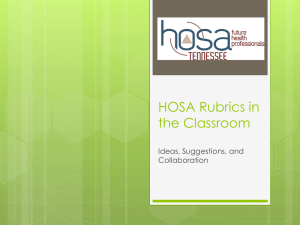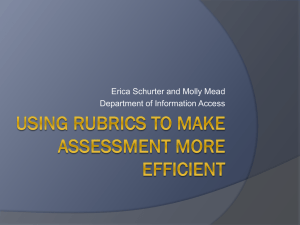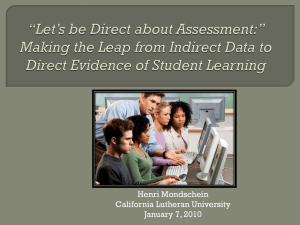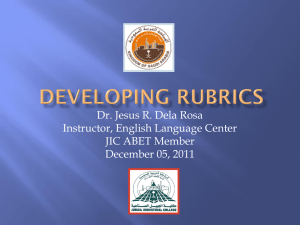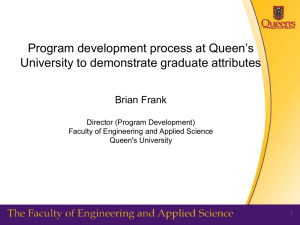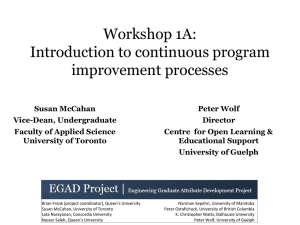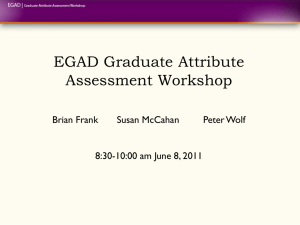PPT Slides
advertisement
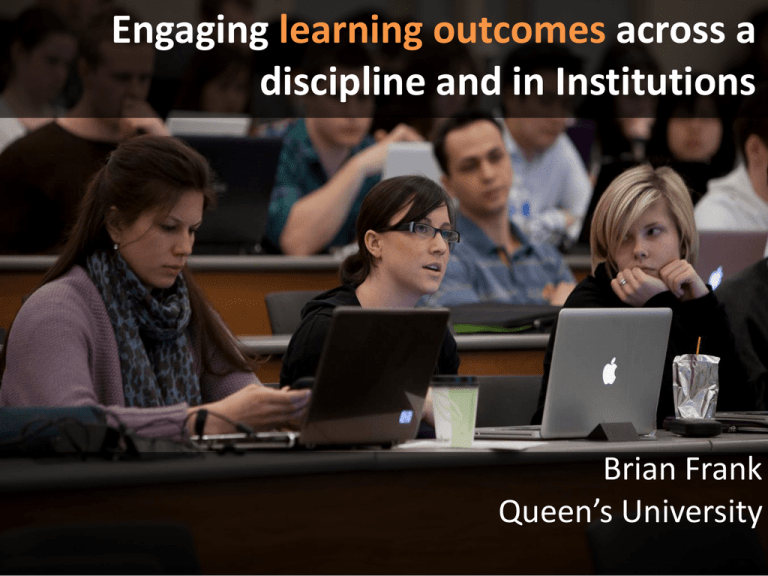
Engaging learning outcomes across a discipline and in Institutions Brian Frank Queen’s University Learning outcomes are not new… E.g. Ontario’s college sector, professional programs in Canada, accreditation requirements in the US …but closing the loop is using evidence from learning outcomes to improve student learning and inform curriculum Survey: Only 6% of 146 profiles of good practice submitted contained evidence that student learning had improved (Banta & Blaich, 2011). Baker, G. R., Jankowski, N. A., Provezis, S., & Kinzie, J. (2012). Using Assessment Results: Promising Practices of Institutions That Do It Well. Retrieved from http://www.tamiu.edu/adminis/iep/documents/NILOA-Promising-Practices-Report-July-2012.pdf 2 Effect size (performance gain in σ) Computer assisted instruction 800 meta-analyses 50,000+ studies 200+ million students Time on task Teaching quality … Problem solving teaching Professional development Hattie, J. (2009). The Black Box of Tertiary Assessment: An Impending Revolution. In Tertiary Assessment & Higher Education Student Outcomes: Policy, Practice & Research (pp.259-275). Wellington, New Zealand: Ako Aotearoa Self-questioning Creativity programs Metacognitive strategies Spaced vs. mass practice Feedback Reciprocal teaching Explicit objectives and assessment Formative evalution to instructor Student self-assessment 0 0.2 0.4 0.6 0.8 1 1.2 1.4 Role of learning outcomes in delivery: Level: Course Program Faculty Institutio n Learning outcomes Assessment Learning & teaching activities • Curriculum and assessment planning • University learning space planning • University-wide student services and academic support planning • Potentially: Competency based credentials Disciplinary, national Institutional, provincial 7 Canadian Engineering Accreditation Board: 3.1: Demonstrate that graduates of a program possess 12 graduate attributes 3.2: Continual program improvement processes using results of graduate attribute assessment 8 Engineering Graduate Attribute Development (EGAD) Project WHO Engineering educators and educational developers across Canada MANDATE Collect and develop resources and training Run annual national workshops, and customized institutional workshops 9 EGAD Workshops 1. Introduction to Continuous Program Improvement Processes 2. Graduate Attribute Assessment as a Course Instructor 3. Creating Useful Learning Outcomes 4. What to Look for in an Outcomes-Based Process 5. Leading a program improvement process 10 11 Example process 1 2 Program objectives and outcomes What do you want to know about the program? Curriculum & process improvement 5 Analyze and interpret 4 Mapping curriculum and assessment planning Collecting evidence 3 Developing or adapting outcomes Tool: Learning outcomes collection Diploma Bachelor Aligning outcomes and curriculum Tool: Curriculum map Masters Knowledge … … … Critical think … … … Writing … … … Interpersonal … … … Aligning outcomes within a course Tool: Course planning table Course 1 Outcome 1 Course 3 Develop Outcome 2 Master/ assess Assess Outcome 3 Develop/a ssess Scoring performance Tool: Rubrics PHYS101 Course Outcomes: Students will: 1. Describe motion of… 2. Predict the behaviour… Assess Course 2 Marginal Meets Outcome 1 … … Teaching Activity Week 1 … … Outcome 2 … … Week 2 … … Outcome 3 … … Week 3 … … Exceeds 13 Software tools 14 HEQCO Learning outcomes consortium Issue No one has effectively closed the loop in Ontario Consortium goal Development of useful learning outcomes assessment techniques and to their wide-scale implementation in their institutions Focus on generic learning outcomes and cognitive skills (critical thinking, communications, lifelong learning, etc.) 15 Learning outcomes consortium 16 Developing or adapting outcomes Tool: Learning outcomes collection Diploma Bachelor Aligning outcomes and curriculum Tool: Curriculum map Masters Knowledge … … … Critical think … … … Writing … … … Interpersonal … … … Aligning outcomes within a course Tool: Course planning table Course 1 Outcome 1 Course 3 Develop Outcome 2 Master/ assess Assess Outcome 3 Develop/a ssess Scoring performance Tool: Rubrics PHYS101 Course Outcomes: Students will: 1. Describe motion of… 2. Predict the behaviour… Assess Course 2 Marginal Meets Outcome 1 … … Teaching Activity Week 1 … … Outcome 2 … … Week 2 … … Outcome 3 … … Week 3 … … Exceeds 17 College sector Durham: Is Student Success ePortfolio effective for assessing Essential Employability Skills (EES) George Brown: Tools & rubrics to assess EES (communication and problem solving) Humber: reliable instrument for reading, writing, critical thinking, and problem solving across curriculum 18 University sector Guelph: Process and tools for mapping & assessment of university-wide learning outcomes using VALUE rubrics Toronto: Analytic rubrics for communications, application of knowledge, and teamwork in engineering Queen’s: Mixed methods assessment of generic learning outcomes across four fields 19 Approaches to direct assessment of learning outcomes across program ①Course-specific criterion-referenced scoring using course deliverables ②Stand-alone standardized instruments ③General criterion-referenced scoring using course deliverables 20 Approaches to direct assessment of learning outcomes across program ①Course specific criterion-referenced scoring using course deliverables • Provide clear guidance to students • Useful for course improvement • Limited ability to assess development over multiple years ②Stand-alone standardized instruments ③General criterion-referenced scoring using course deliverables 21 Example: Leveled outcomes for each year Theme Communications Process Written Oral Graphical First year Second year Describes typical expectations engineers to communicate effectively. Third year Graduating year Generates a traceable Writes and revises and defensible record of documents using a technical project using appropriate disciplinean appropriate project specific conventions records system. Summarizes and Composes documents Demonstrates Write concise, coherent paraphrases written in styles including conciseness, precision, and grammatically work accurately with progress reports, and clarity of language in correct materials that appropriate citations professional career technical writing. reflect critical analysis (cover letters, CV, RFP), and synthesis, design reports appropriate to audience needs. Delivers clear and Delivers effective Demonstrates formal Demonstrates organized formal formal oral oral presentations with confidence in formal and presentation following presentations including appropriate language, informal oral established guidelines appropriate facial style, timing and flow. communications gestures, natural body posture and movement Creates effective Creates accurate and Uses graphics to explain, figures, tables, and complete technical interpret, and assess drawings employing graphics. information standard conventions to compliment text. 22 E.g. Course specific outcomes assessed using course deliverables 7-8 outstanding Info. summary Selfreflection Arguments Written comm. … … … … 5-6 3-4 expectation marginal Summarizes and assesses credibility... Analysis identifies limitations... Claims supported by data… Clearly formatted with… … 0-2 below GRADE /8 … … … … /8 … /8 … … /8 23 Performance by outcome within a course 60 Percentage (%) 50 40 30 20 10 0 FEAS - 3.12-FY1 FEAS - 3.12-FY2 FEAS - 3.12-FY5 FEAS - 3.12-FY6 Attributes 1 - Not Demonstrated 2 - Marginal 3 - Meets Expectations 4 - Outstanding 3.12-FY1 Uses information effectively, ethically, and legally to accomplish a specific purpose, including clear attribution of Information sources. 3.12-FY2 Identifies a specific learning need or knowledge gap. 3.12-FY5 Identifies appropriate technical literature and other information sources to meet a need 3.12-FY6 Critically evaluates the procured information for authority, currency, and objectivity. 24 Approaches to direct assessment of learning outcomes across program ①Course specific criterion-referenced scoring using course deliverables ②Stand-alone standardized instruments (CLA, etc.) – Measure development over multiple years, institutional comparison. Validity & reliability data. – Can be expensive, measure limited set of skills – Low completion rates, poor motivation particularly fourth year students, so results suspect ③General criterion-referenced scoring using course deliverables 25 Approaches to direct assessment of learning outcomes across program ①Course specific criterion-referenced scoring using course deliverables ②Stand-alone standardized instruments ③General criterion-referenced scoring using course deliverables • • • • • Can assess development over multiple years No additional student work, so no problem with motivation, completion rates Encourages alignment between program course outcomes and course delivery Requires some additional grading time Limited availability of validated rubrics 26 Valid Assessment of Learning in Undergraduate Education (VALUE) Rubrics • Meta-rubrics that synthesize the common criteria and performance levels gleaned from numerous individual campus rubrics for 14 Essential Learning Outcomes • Can be used to mimic approach taken by some critical thinking tests that allow programs to provide their own “artifact” that is scored against a common set of criteria 27 Rhodes, Terrel, ed. 2010. Assessing Outcomes and Improving Achievement: Tips and Tools for Using Rubrics. Washington, DC: Association of American Colleges and Universities. 28 Assessing development using VALUE rubrics A. Greenhoot, D. Benstein, Using VALUE Rubrics to Evaluate Collaborative Course Design, Peer Review, vol. 13 no. 4, AAC&U 29 Queen’s approach: piloting general outcomes in 4 fields Physical science Social science Engineering Humanities 30 Outcomes assessment plan over three years Outcome 1. Course specific scoring Critical thinking If available Problem solving If available Written comm. If available Lifelong learning If available 2. Standard tool (limited cohort) 3. General scoring (VALUE) 4. Think aloud CLA or CAT Critical thinking Local CLA or CAT Problem solving Local CLA or CAT Written comm LASSI, MLSQ Info lit/lifelong learn SRLIS 31 Engaging learning outcomes across a discipline and in Institutions If you don’t know where you’re going, you’ll probably end up somewhere else. Brian Frank Queen’s University OTHER SLIDES (USED ONLY IF THERE ARE QUESTIONS) Engineering Graduate Attribute Development (EGAD) Project 33 CEAB requirements include: a) Identified learning outcomes that describe specific abilities expected of students b) A mapping of where attributes are developed and assessed within the program c) Description of assessment tools used to measure student performance (reports, exams, oral presentations, …) d) An evaluation of measured student performance relative to program expectations e) a description of the program improvement resulting from process 34 Performance by student in a course Number of students 400 350 344 Below target Below threshold 300 228 250 187 200 150 100 50 26 42 6773 65 62 46 38 45 0 0 1 2 3 4 100 7 5 20 41 0 0 25 0 10 0 2 0 2 0 0 0 6-10 11-15 16-20 21-25 26-30 31-35 36-40 41-50 Number of indicators Engineering Graduate Attribute Development (EGAD) Project 35 environmental individual 4 approaches to facilitating change Disseminating (good for knowledge, poor for long term change) Enacting Policy prescribed Supporting individual innovators Developing shared vision emergent Effective strategies: are aligned with or seek to change beliefs, long-term interventions, understand university as a complex system, honest about issues and problems. Henderson, C., Beach, A., & Finkelstein, N. (2011). Facilitating change in undergraduate STEM instructional practices: An analytic review of the literature. Journal of Research in Science Teaching, 48(8), 952–984. doi:10.1002/tea.20439 36 Adopting change 37 Software packages evaluated • • • • • • • Canvas Desire2Learn eLumen LiveText Moodle Waypoint Outcomes (No response from Blackboard) Engineering Graduate Attribute Development (EGAD) Project Want to merge into one tool! 38 Engineering Graduate Attribute Development (EGAD) Project 39 Assessment Analytics Engineering Graduate Attribute Development (EGAD) Project 40 Software summary • Desire2Learn is the closest to a complete package to manage courses, learning outcomes, rubrics, and reporting; Analytics tool in early stages • eLumen outstanding at analysis, but poor integration into general LMS • Waypoint Outcomes/LiveText outstanding at managing outcomes, rubrics, and feedback Engineering Graduate Attribute Development (EGAD) Project 41 Norm referenced evaluation Grades Student: You are here! (67%) Used for large scale evaluation to compare students against each other Criterion referenced evaluation Student has marginally met expectations because submitted work mentions social, environmental, and legal factors in design process but no clear evidence of that these factors Impacted on decision making. Used to evaluate students against stated criteria Engineering Graduate Attribute Development (EGAD) Project 42
